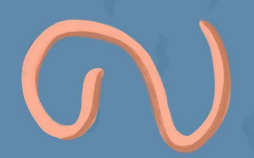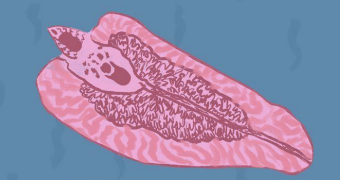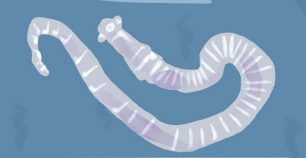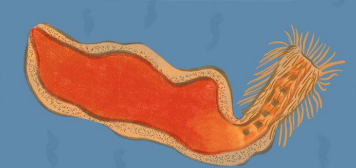Parasitology II: Identification of Medically Important Helminths
1/129
There's no tags or description
Looks like no tags are added yet.
Name | Mastery | Learn | Test | Matching | Spaced |
|---|
No study sessions yet.
130 Terms
a: Helminths
q: Multicellular parasitic worms that infect humans
a: General features of helminths
q: Elongated, bilaterally symmetrical organisms with developed organ systems
a: Ingestion (helminth transmission)
q: Mode of transmission involving swallowing infective eggs or larvae
a: Skin penetration (helminth transmission)
q: Mode of transmission where larvae actively enter through the skin
a: Vector transmission (helminth transmission)
q: Mode of transmission involving an arthropod carrying infective stages
a: Helminths
q: Parasitic organisms that cause significant morbidity particularly in tropical regions
a: Helminths
q: A child playing barefoot in contaminated soil later develops anemia and itchy skin lesions. The parasite likely entered through skin penetration. What group of parasites is involved?
a: Impact on human health of helminths
q: Health effects caused by helminth infections, including reduced red blood cells, poor nutrition, and damage to organs
a: Global prevalence and burden
q: Widespread occurrence and significant health burden of helminth infections worldwide
a: Importance in pharmaceutical and diagnostic fields
q: The relevance of helminths in developing medications and diagnostic tests
a: Helminths
q: A patient in a tropical region shows signs of anemia, malnutrition, and liver enlargement. Healthcare providers need to consider treatments and tests targeting parasitic worms. What group of organisms is responsible?
roundworms

flukes

tapeworms

thorny-headed worms

a: Nematodes
q: Helminths with elongated, cylindrical bodies, also called roundworms
a: Trematodes (flukes)
q: Helminths that are flat, leaf-shaped, and often infect bile ducts, liver, or blood
a: Cestodes (tapeworms)
q: Helminths that are long, segmented, and mainly infect the intestines
a: Thorny-headed worms (Acanthocephalans)
q: Helminths with a spiny proboscis, primarily infect animals and rarely humans
a: Nematodes, Trematodes, Cestodes, Acanthocephalans
q: The main groups of helminths distinguished by body shape and infection site
a: Key morphological differences
q: Differences in body structure, segmentation, and organ system development among helminths
a: Nematodes (roundworms)
q: A child develops itchy perianal itching at night and abdominal discomfort. The parasite is cylindrical and lives in the intestines. Which helminth group is most likely involved?
a: Trematodes (flukes)
q: A patient in a rural area with history of swimming in freshwater has liver enlargement and anemia. Tests reveal flat, leaf-shaped worms in the bile ducts. Which helminth group is this?
a: Cestodes (tapeworms)
q: An adult reports passing long, segmented worms in the stool after eating undercooked beef. What type of helminth is most likely responsible?
a: Thorny-headed worms (Acanthocephalans)
q: A zookeeper reports a rare intestinal infection in humans caused by a spiny-headed worm from animals. Which helminth group does this belong to?
a: Helminth classification by group (Nematodes, Trematodes, Cestodes, Acanthocephalans)
q: A patient presents with intestinal symptoms, while another has liver infection and yet another has a blood-dwelling parasite. What classification system helps distinguish these helminths?
a: Cylindrical, unsegmented
q: Body shape and segmentation of nematodes
a: Complete digestive tract
q: Digestive system type of nematodes
a: Separate sexes (dioecious)
q: Sexual organization of nematodes
a: Egg → larva → adult
q: Stages in the life cycle of nematodes
a: Intestines, blood, lymph, tissues
q: Typical locations in the human body where nematodes can be found
a: Nematode
q: A patient presents with intestinal obstruction. Laboratory tests show a cylindrical, unsegmented worm with a complete digestive tract. What type of helminth is this?
a: Dioecious
q: A male and female nematode are observed in different hosts during a study. What term describes their sexual organization?
a: Lymph
q: A patient shows filarial infection in the lymphatic system. Which type of nematode habitat does this exemplify?
a: Ascaris lumbricoides
q: Roundworm species that infects the human intestines and is one of the most common nematodes
a: Enterobius vermicularis
q: Nematode causing perianal itching, especially in children
a: Trichuris trichiura
q: Whipworm that infects the large intestine
a: Hookworms
q: Nematodes that attach to the intestinal wall and feed on blood
a: Fecal-oral route and skin penetration
q: Two main modes of transmission for intestinal nematodes
a: Abdominal pain, diarrhea, malnutrition
q: Common symptoms caused by intestinal nematode infections
a: Ascaris lumbricoides
q: The largest intestinal roundworm that infects humans
a: Ingestion of embryonated eggs
q: Mode of transmission for Ascaris lumbricoides
a: Eggs in feces
q: Diagnostic stage of Ascaris lumbricoides
a: Thick-shelled eggs; adult with tapered ends
q: Characteristic features of Ascaris eggs and adult morphology
a: Ascaris lumbricoides
q: Scientific name of the giant intestinal roundworm
a: Giant intestinal roundworm
q: Common name of Ascaris lumbricoides
a: Nematoda
q: Phylum to which Ascaris lumbricoides belongs
a: Secernentea
q: Class of Ascaris lumbricoides
a: Small intestine (mainly jejunum)
q: Main habitat of Ascaris lumbricoides in humans
a: Worldwide, highly prevalent in tropical and subtropical areas with poor sanitation
q: Global distribution pattern of Ascaris lumbricoides
a: Humans (definitive host only)
q: Type of host for Ascaris lumbricoides
a: Long, cylindrical, tapering at both ends; creamy white or pinkish
q: General body shape and color of adult Ascaris lumbricoides worms
a: 15–30 cm long, posterior end curved ventrally, with two spicules
q: Size and distinguishing feature of male Ascaris lumbricoides
a: 20–40 cm long, straight posterior end, vulva located at anterior third
q: Size and distinguishing feature of female Ascaris lumbricoides
a: Round/oval, thick mammillated shell, golden brown, 60×45 μm
q: Shape, shell type, color, and size of fertilized Ascaris lumbricoides eggs
a: Elongated, thinner shell, irregular contents
q: Characteristics of unfertilized Ascaris lumbricoides eggs
a: Decorticated egg
q: Type of Ascaris egg that lacks mammillations due to chemical washing or bile action
a: Feces
q: Where Ascaris eggs are initially passed from an infected person
a: Embryonation
q: Environmental process that occurs in soil within 2–4 weeks, making eggs infective
a: Ingestion of embryonated eggs via contaminated food, water, or hands
q: How humans acquire Ascaris infection
a: Small intestine
q: Where Ascaris larvae hatch and initially penetrate in the human body
a: Liver → heart → lungs (alveoli)
q: Pathway of larval migration after entering the bloodstream
a: Molt twice, ascend the trachea, are swallowed
q: Process that occurs in the lungs before larvae return to the intestine
a: 1–2 years
q: Typical lifespan of adult Ascaris worms in the small intestine
a: Embryonated egg
q: Stage of Ascaris lumbricoides that is infective to humans
a: Fertilized egg in feces
q: Stage of Ascaris lumbricoides used for diagnosis
a: Loeffler’s Syndrome
q: Lung-related hypersensitivity reaction caused by migrating Ascaris larvae
a: Cough, wheezing, transient pulmonary infiltrates, eosinophilia
q: Symptoms associated with Loeffler’s Syndrome
a: Intestinal phase
q: Phase of Ascaris infection where worm burden leads to malnutrition and abdominal pain
a: Intestinal obstruction
q: Serious complication caused by heavy Ascaris infection in children
a: Bile duct, appendix, pancreatic duct
q: Possible abnormal migration sites of Ascaris worms
a: Cholangitis
q: Condition caused by Ascaris entering the bile duct
a: Appendicitis
q: Condition caused by Ascaris entering the appendix
a: Pancreatitis
q: Condition caused by Ascaris entering the pancreatic duct
a: Intestinal perforation
q: Serious complication where the intestinal wall is damaged by heavy worm burden
a: Biliary ascariasis
q: Condition involving Ascaris worms entering and obstructing the biliary tract
a: Migration during anesthesia
q: Situation in which Ascaris worms may migrate due to reduced gut tone from muscle relaxants
a: Fertilized egg
q: Ascaris stage that is thick, mammillated, golden brown
a: Fertilized egg
q: Most diagnostic form of Ascaris found in stool
a: Unfertilized egg
q: Ascaris egg that is elongated with a thin shell
a: Presence of female worms only
q: What the presence of unfertilized Ascaris eggs indicates
a: Adult (male/female)
q: Large, cylindrical Ascaris stage with tapering ends
a: Adult worm
q: Ascaris stage sometimes found during intestinal obstruction or passed in stool
a: Embryonated egg in soil
q: Infective stage of Ascaris found in the environment
a: Embryonated egg in soil
q: Ascaris stage that is the key target for prevention
a: Enterobius vermicularis (Pinworm)
q: Common intestinal nematode in children that causes perianal itching
a: Perianal itching
q: Main symptom associated with Enterobius infection
a: Ingestion or inhalation of eggs
q: Modes of transmission for Enterobius vermicularis
a: Scotch tape test
q: Diagnostic method used to detect Enterobius eggs on perianal folds
a: Small, white worms
q: General appearance of adult Enterobius worms
a: D-shaped eggs
q: Characteristic shape of Enterobius eggs
a: Enterobius vermicularis
q: Scientific name of the parasite commonly known as pinworm
a: Pinworm, Seatworm, Threadworm
q: Common names for Enterobius vermicularis
a: Nematoda
q: Phylum to which Enterobius vermicularis belongs
a: Cecum, appendix, colon, and rectum
q: Primary habitat of Enterobius vermicularis in the human body
a: Worldwide; most common in temperate climates
q: Global distribution pattern of Enterobius vermicularis
a: Humans (only known host)
q: Host type for Enterobius vermicularis
a: Children and institutional populations
q: Population groups with highest prevalence of Enterobius infection
a: White, threadlike, with a pointed tail (pin-like)
q: General color and appearance of adult Enterobius vermicularis worms
a: 2–5 mm long; posterior end curved ventrally
q: Length and distinguishing feature of male Enterobius worms